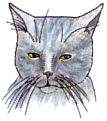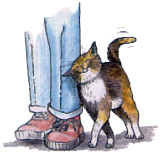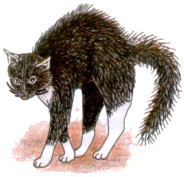Cat talk
Read Cat Talk by D.S. Long (School Journal, Pt 3, No. 1, 1990). On the chart below write down what the cat is trying to say and all the things the cat is doing to show this. The first one has been done for you.
| Cat | What is the cat trying to say? | What are all the things the cat is doing that shows what it is trying to say? |
a)  |
|
|
b) |
|
|
c) |
|
|
d) |
|
|
e) |
|
|
f) |
|
|
g) |
|
|
This resource helps to identify students’ ability to:
- interpret illustrations
- integrate ideas across a small range of texts
as described in the Literacy Learning Progressions for Reading at: http://www.literacyprogressions.tki.org.nz/The-Structure-of-the-Progressions.
|
Y6 (05/2002) |
|||
| b) |
i) |
Hello. |
easy |
| c) |
i) |
You are part of my family. |
easy |
| d) |
i) |
I feel angry. |
easy |
| e) |
i) |
Any 1 of:
Any 4 of:
|
moderate |
| f) |
i) |
I feel frightened.
|
difficult |
| g) |
i) ii) |
I submit/You're the boss. Any 2 of:
|
difficult 2 correct - very difficult 1 correct - |
| Common Error | Likely Reason | |
| c) i) | 8% of students wrote "scratch my tummy" or a similar answer. | Students based the interpretation of the pictures on their own prior experience and beliefs about the meaning of cats' body language rather than on the information provided in the text. |
| f) i) |
14% of students wrote "I am alert" or "I am listening/looking at something." 9% of students wrote "I am scared/frightened." 9% of students wrote "I am ready to protect myself." |
|
| h) i) |
12% of students wrote "I am ready to fight/attack." 8% of students wrote "I am angry." |
|
Cat Talk
by D.S. Long
Anyone can learn cat "talk". It's not easy. It takes lots of practice. But it can be done. Cats do use sounds - you hear them when they are fighting - but like signers of New Zealand Sign Language, cats mainly use body language. What follows is a kind of dictionary. A dictionary of Cat. Few dictionaries are complete. This one certainly isn't. But it will get you started. Good luck.
Purring
Most people think that cats purr when they are happy. But sick and injured cats purr, too. Purring expresses friendship. Purring can also mean "dinner's served". Try it the next time you feed a cat.
Saying "Hello"
Does your cat roll over when you come home, and twitch the tip of its tail? Some people think that means "scratch my tummy". Most cats don't like their tummies touched. Rolling over is a sleepy way of saying "hello".
You're the boss
Making yourself as flat as possible, not looking at anyone directly and keeping quiet, is another way to submit in Cat. It's a bit like the way some people behave on their first day at a new school.
Scent sharing
Cats have a special way of saying, "You are part of my family." They rub against us with the sides of their mouth, temple, and tail. Then they sit down and lick themselves. When your cat does this to you, it is marking you with its scent. Afterwards, it licks its own fur to taste your scent. So if you don't want to belong to a cat, move away.
Head bumping
When cats just want to say a quick "Hi!" they bump heads. If you have a cat among your friends, you might like to try this. It will know exactly what you mean. This is not the same as the repeated bumping. That means, "Please, please, please."
Whisker "words"
A curious cat sticks its whiskers straight out. They twitch with excitement. Bored cats have droopy whiskers. Contented cats let their whiskers lie flat against their faces and half-close their eyes. But watch out, because wide-eyed cats with flattened whiskers are frightened.
Sitting down
Sometimes we "say" things to cats we don't really mean to say. Does your cat climb on to your lap when you sit down? Does it then begin to knead you with its paws, loudly purring? When mother cats lie down, this is how kittens get milk to come. Most people push their cats off at this point, when the claws prick their skin. But by sitting down, they have, in cat language, offered to give milk. So it would really be kinder to go and fetch a saucer and get a little milk from the fridge.
Tail waving
One reason cats have trouble understanding us is because we don't have tails. Cats wave their tails when they are trying to make up their minds. As soon as they make a choice, the waving stops. When a cat stalks a bird, it often waves its tail. This is because it's trying to decide whether to pounce or creep.
Tail swishing
A swishing tail says something quite different. Most people learn the hard way that it means, "I'm angry. Watch out."
Fluffy tail
Frightened cats "say" fluffy tail. They probably can't help themselves. It's a bit like us saying, "Ouch".
Flagpole tail
Some cats use a straight raised tail to say, "Hello". Petting (sharing your scent) is a polite reply.
Claws in - claws out
A clawless pat means, "I want something." If the claws are out, that's fighting talk.
Ear talk
Ears are a problem when you want to talk Cat. If you could show the backs of your ears, you could say, "I'm ready to fight." If you could flatten your ears, you could say, "I'm ready to protect myself." Pricked ears could show you were alert. A curious cat will say, "Well, well, well, what have we here?" by approaching carefully, with ears pricked forward and twitching one at a time.
Fighting talk
When two cats come together for a fight, they make themselves look big. Their fur fluffs up. They "walk tall". They stare at each other and twist their heads from side to side, as if in the middle of a bite. They show the backs of their ears and howl. If you stare at a strange cat and slowly approach, it won't like it. Staring at something calls it "prey". If your cat walks on to a book you're reading, it may have come to see what you plan to catch. Try staring at a distant chair if you want to get rid of your cat for a bit. (This is to tell a lie in Cat.)
Hissing
A threatened cat will hiss and spit. It will thrash its tail and show its fangs. Its ears will lie flat and its eyes will dilate.
Crab walking
Sometimes cats "say" two different things at once. When a cat is thinking about attacking and running away, it may do both. Crab walking results when the front paws are retreating and the back paws are attacking.
Paw wiping
To tell a cat to "get lost", try standing side on and wiping the bottom of your foot against the ground. It's a very strong thing to "say". Don't do it unless you really mean it.
Teaching humans to hunt
Kittens are taught to hunt. First they are shown how to eat mice. Next they are given dead mice to play with. Then they are given wounded mice to kill. If your cat brings a mouse home, it thinks you are old enough to learn how to hunt. Your cat will tell you what level it thinks you're up to.
Licking
Does your cat lick you? Your cat is trying to groom you by licking your fur. You are expected to lick back. It's just another way of saying, "We are a family." You can reply by stroking your cat or giving it a brush. Refusing to lick or stroke back says, "I'm displeased with you."
One final hint
When cats talk, they "speak" with their tails, fur, posture, ears, eyes, and whiskers all at once. They may even make sounds. In this "dictionary" this is all separated out – but to really talk Cat, you'll need to combine things back together again. Don't worry. A cat that loves you will understand, even when you can only say one thing at a time.

